#Amenhotep IV
Explore tagged Tumblr posts
Text
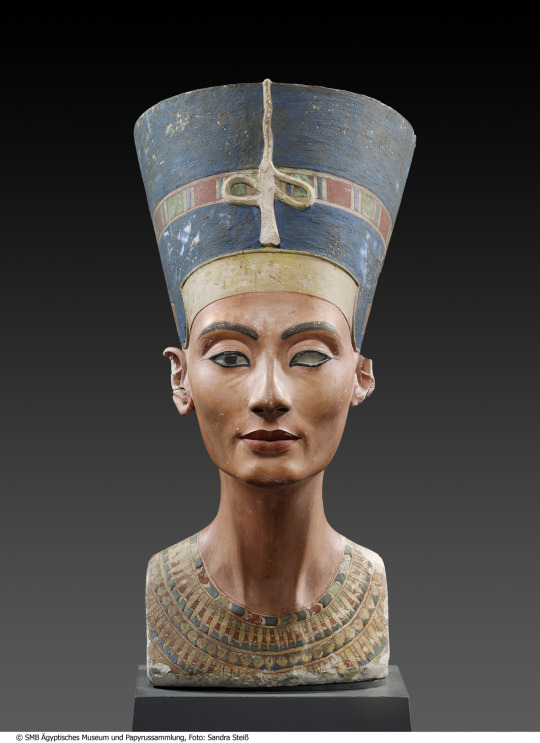
~ Bust of Queen Nefertiti.
Period: 18th Dynasty, New Kingdom; reign of Amenhotep IV/Akhenaten
Medium: Limestone, painted; stucco; beeswax, black; rock crystal.
#ancient#ancient art#history#museum#archeology#ancient egypt#ancient sculpture#ancient history#archaeology#egypt#egyptian#egyptology#Nefertiti#new kingdom#18th Dynasty#Amenhotep IV#Akhenaten
1K notes
·
View notes
Text

Bust of a Pharaoh Dating: Amenhotep IV / Akhenaten (18th Dynasty -> New Kingdom -> Egypt) Neues Museum, Berlin, Germany
#Amenhotep#Amenhotep IV#egypt#egyptian#art#bust#world history#18th dynasty#archaeology#Akhenaten#new kingdom#limestone#background blacked out
275 notes
·
View notes
Text

Exclusive pictures from the Golden City of the Aten (Tjehen-Aten), recently discovered site on the West Bank of Luxor, inhabited during the reigns of Amenhotep III, Amenhotep IV/Akhenaten, Smenkhkare, Nefertiti and Tutankhamun.
#amarna period#akhenaten#amenhotep iii#amenhotep iv#Smenkhkare#nefertiti#tutankhamun#Egypt#Egyptian#ancient Egypt#ancient Egyptian#Luxor#thebes#Kemet#Kemetic#waset
77 notes
·
View notes
Photo
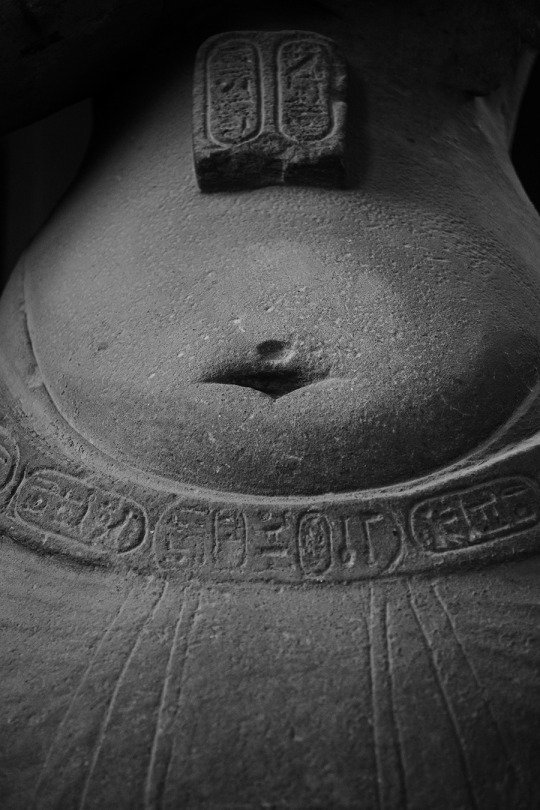

Studies of Akhenaten’s belly button. (Cairo Diary, 2022)
#pharaoh#belly button#akhenaten#amenhotep iv#cairo museum#egypt#sculpture#echnaton#Ancient Egypt#egyptology#diary#black and white
111 notes
·
View notes
Text

No way, is this Akhenaten again? Yes.
13 notes
·
View notes
Quote
Shine, reborn! Rise splendidly!
King Akhenaten, Echoes of Egyptian Voices: An Anthology of Ancient Egyptian Poetry
27 notes
·
View notes
Text


made a risograph print of Aten inspired by my art of ancient egypt class! if anybody’s interested in purchasing one, i’m selling them for $12! dm me if interested :)
enjoy!
#my art (s-zephyr)#Aten#ancient egypt#illustration#risograph print#risograph#art history#amenhotep iv#akhenaten#amarna#the whole story of akhenaten at amarna was chilling to learn about#and i love aten’s design without context– but with context it’s even more fascinating
5 notes
·
View notes
Text
The Legacy of Pharaoh Akhenaten in Ancient Egypt
Akhenaten, also known as Amenhotep IV, was a fascinating African figure in ancient Egyptian history, reigning as pharaoh from around 1353 to 1336 or 1351 to 1334 BC. He was the tenth ruler of the Eighteenth Dynasty and is particularly renowned for his radical religious reforms. Before the fifth year of his reign, he was known as Amenhotep IV, but he later gained fame for abandoning Egypt’s…
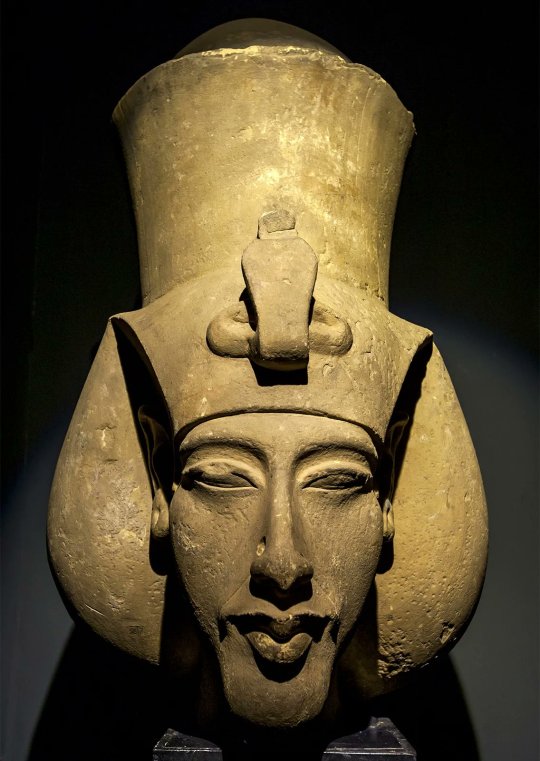
View On WordPress
#African History#Akhenaten#Amenhotep IV#ancient Egypt#ancient Egyptian pharaoh#Ancient Egyptians#ancient egyptians history#North African Historical Figure#North African History
1 note
·
View note
Text
if you want actual like on god for real actually exist you can see the papyri/tablets very incredibly cute egyptian letters absolutely go read translations of the amarna letters between king amenhotep III and his absolute bestest best friend in the whole wide world king tushratta of mitanni
#an fyi before you do: egyptians said 'i love you' and were very dramatic about it VERY freely#this isnt a 'haha they were SUUUHC GOOD FRIEEEEEEEENDS' moment egyptians were just like that#amenhotep was INCREDIBLY drunk on loving his wife juice to the extent his secondary wives were merely ceremonial positions#by all accounts he was monogamous and incredibly cute about his (commoner) wife#but he and tushratta referred to eachother as brothers and tush was DEVESTATED when amenhotep died#and wrote to queen tiye saying that he would love his son (amenhotep IV aka akhenaten) as if he were amenhotep III#because his best friend lived on in his son#and was basically like 'my son now i love him so much btw'#and then akhenaten completely fucked it by leaving him on read forever which is so sad and also biggest dick move#akhenaten apologists dont interact
2K notes
·
View notes
Text
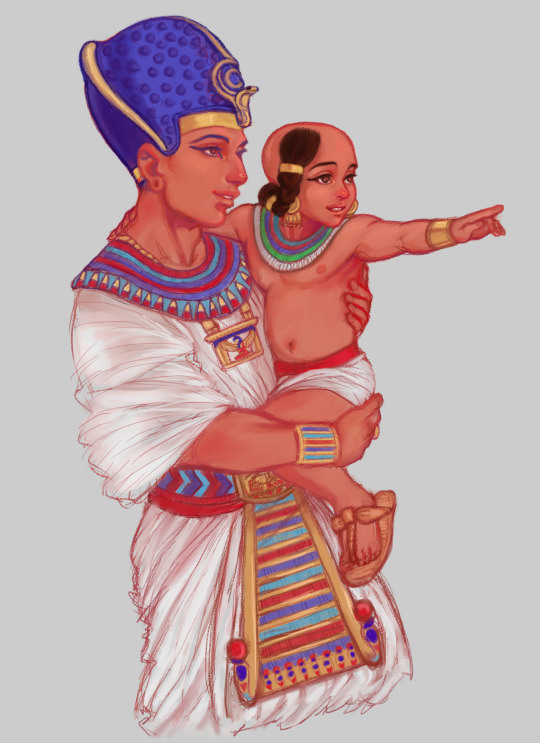
They are looking at the freshly repainted Giza Sphinx idk
#old art from 2020#thutmose iv 🥺#baby amenhotep iii 💗#old.old art#imma try to do more art this yearrrrr#ancient egypt#thutmose iv#amenhotep iii#my art
456 notes
·
View notes
Text

Stele of the lector priest of Amun Siamun and his mother the singer Amenhotep
This stele depicts the Lector-priest Siamun and his mother, the singer Amenhotep, receiving offerings from "his sister" (probably his wife), the chantress Iretnofret.
New Kingdom, 18th Dynasty, reign of Amenhotep II-Thutmose IV, ca. 1420 BC. Now in the Metropolitan Museum of Art. 1970.49
224 notes
·
View notes
Text




"Splendid You rise in the lightland of the sky, O living Aten, creator of life ! You have dawned in the eastern lightland. You fill every land with your beauty." -Great Hymn to the Aten, 1-4.
Aten/Aton Talon Abraxas
Ancient Egyptian Aten: Sun God And Creator Deity Symbols: sun disk, heat and light of the sun Cult Center: Akhetaten (Tel El-Amarna) Aten was a being who represented the god or spirit of the sun, and the actual solar disk. He was depicted as a disk with rays reaching to the earth. At the end of the rays were human hands which often extended the ankh to the pharaoh. Aten's origins are unclear and he may have been a provincial Sun-god worshipped in one of the small villages near Heliopolis. Aten was called the creator of man and the nurturing spirit of the world. In the Book of the Dead, Aten is called on by the deceased, "Hail, Aten, thou lord of beams of light, when thou shinest, all faces live." It is impossible to discuss Aten without mentioned his biggest promoter, the pharaoh Amenhotep IV, or Akhenaten. Early in his reign, Akhenaten worshipped both Amon (the chief god in Thebes at the time) and Aten. The first as part of his public duties, the latter in private. When he restored and enlarged the temple of Aten first built by his father Amenhotep III, relations between him and priests of Amon became strained. The priests were a major power in Egypt and if another god became supreme they would lose their own prestige. Eventually, relations became so strained that Akhenaten decided to built his own capital by the Nile, which he called, "Akhetaten", the Horizon of the Aten. At Akhetaten, Akhenaten formed a new state religion, focusing on the worship of the Aten. It stated that Aten was the supreme god and their were no others, save for Akhenaten himself. It has been said that Akhenaten formed the first monotheistic religion around Aten. However, this is not the case. Akhenaten himself was considered to be a creator god and like Aten was born again every day. Aten was only accessible to the people through Akhenaten because Akhenaten was both man and part of the cosmos. Akhenaten systematically began a campaign to erase all traces of the old gods, especially Amon. He erased the name of Amon from the temples and public works. He even went so far as to erase his own father's cartouche because the word "Amon" was featured in it. Even the word "gods" was unacceptable because it implied there were other deities besides Aten. It is clear that the Egyptian people never accepted their king's religion and view of the world. Even at his own capital, Akhetaten, amulets featuring Bes and Tauret have been found. Following Akhenaten's death, Atenism died rapidly. Mostly because the people never really believed in it and also because Akhenaten's successors did all they could to erase Akhenaten and Aten from the public eye. Eventually, Akhetaten became abandoned and the name "Akhenaten" conjured the dim memory of a "heretic king."
93 notes
·
View notes
Text

The so-called Golden City of the Aten (original name Tjehen-Aten 'Shining Aten'). One of the latest discoveries on the West Bank of Luxor. It seems to be a town associated with the palace of Malqata, the end of the reign of Amenhotep III and the beginning of the reign of Amenhotep IV (Akhenaten). Anyway, more pics shortly as I actually got to explore it later in the day. :)
#Aten#amenhotep iii#Akhenaten#amenhotep iv#golden city#Tjehen-Aten#Luxor#thebes#waset#Kemet#Kemetic#pharaoh#Malqata#ancient Egypt#Egypt#egyptology#ancient Egyptian#Egyptian
31 notes
·
View notes
Note
Nefretiti
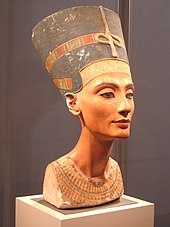
Neferneferuaten Nefertiti, or Nofretiti, (14th century BC; 18th dynasty, New Kingdom) is perhaps best well known for her bust, which has become world famous for its' uniqueness and craftsmanship. But Nefertiti played a role in one of the most controversial eras of Egyptian history. She is one of the most well-recorded Queens of ancient Egypt, but very little is known about her actual life besides conjecture.
Let's start with dissecting her name. Most people will divide her name up into the words Nefer and Titi; Nefer being a common word in ancient Egypt meaning beauty and goodness. In actuality, her name is divided up as neferet - iiti, more classically transliterated as Nfr.t-jy.tj. The t belongs to nefer as it is the denomination of a female pronoun in the ancient Egyptian language, and the jy.tj means coming or has come. All together, her name means The Beautiful One Has Come.
Nefertiti is indeed beautiful; she is, as mentioned earlier, one of the most depicted Queens of Egyptian history, with her image appearing on a great number of walls, in carvings and in paintings, and of course, statues. The reason for this is partly due to her marriage to the Heretic Pharaoh, Akhenaten. To understand this connection a little better, one must have some background about the Pharaoh Akhenaten.
Akhenaten and Nefertiti were married close to when Akhenaten was coronated, which was for him around the age of 16 or 18, and for Nefertiti was around the age of 12 to 16. Akhenaten is fairly well known Pharaoh. His controversial history has made sure of that, despite the fact that after he died, the following Pharaohs did everything in their power to rid Egypt of his memory by destroying his city and erasing all images of him. Akhenaten started off as Amenhotep IV––a name which connects him to the Egyptian God Amun, often associated with the sun, but representing hiddenness, and one of the highest and most powerful Gods of Egypt. The cult of Amun at the time of the New Kingdom was perhaps the most widespread cult of worship in Egypt, and the 18th dynasty, to which the Pharaoh Amenhotep IV belongs, is the first dynasty of the New Kingdom.
This was, apparently, unsatisfactory for the Pharaoh Amenhotep IV. Still, for the first 5 years of his reign, he followed Amun's cult, until he made a dramatic religious change to worship of the Aten; a new God that represented the sun disc. Aten was a faceless God, and the first mention of the word aten was in the Old Kingdom, and back then, it meant 'disc'. While Aten was worshipped as a mere aspect of Ra, the Sun God, in Amenhopte IV's father's (Amenhotep III) reign, Amenhotep IV decided that the Aten should be the primary deity worshipped. Amenhotep IV changed his name to Akhenaten, and worshipped the Aten above all else, as the nurturer of the world, the creator, and the giver of life. This would've likely been fine; however, Akhenaten decided that the Aten should be the only God worshipped, and banned the worship of all other Gods.
Ancient Egypt had been polytheistic since it's very earliest beginnings. Akhenaten essentially introduced monotheism out of nowhere and insisted all his subjects follow him in his new faith, outlawing all other worships, and forcing many priests to abandon the temples of other Gods. Additionally, ancient Egyptians were very accustomed to using an image to worship a God; the image usually being an animal, human, or an animal-headed human. But the Aten was a disc. Although the Aten had been worshipped in Amenhotep III's reign as a falcon-headed solar deity, Akhenaten insisted that the Aten be only shown as a disc with rays reaching out, with small hands on each ray.
Obviously, this caused a lot of dissent in Egypt and the following reigns.
Another interesting point of contention was the fashion in which the Aten interacted with the royal family. In the past, the Pharaoh was connected to the Gods more than any other human––he was the bridge between the two worlds, and the mediator between humanity and the Gods. This was, generally, not a task shared by the whole of the royal family. But in Atenism, the Aten would only shine its life-giving rays onto the Pharaoh and his royal wife; in this case, Akhenaten and Nefertiti. Thus the people, if they wanted to experience the life and love of the only, legally worshippable God, would have to go through the Pharaoh and his wife. This power would've likely, at least in part, been given to the royal family in order to cement their changes, and protect them from any backlash.
This massive change in culture and religion had great affects on ancient Egypt at the time. The style of ancient Egyptian art changed drastically, and the figures of the royal family were now represented as sinuous and gangly, often with large, sagging bellies and breasts, and curved, graceful facial features. Since Akhenaten and Nefertiti, as the royal family, were so important to this new religion of Atenism, the two of them were depicted in a number of scenes––many of them unique to the Amarna period, which is the name for the period in which Atenism was installed. These scenes were familial in nature; depicting the royal couple sitting with their children and bathing in Aten's life-light, throwing gifts down to the people, and engaging with one another. This is one of the main reasons that Nefertiti is the most widely-depicted Queen of Egypt. Not only is she depicted often as the wife of Akhenaten, but she is drawn in her own right––she makes offerings to the Aten on her own, and there are depictions of her smiting the enemies of Egypt, which is a role traditionally given solely to the Pharaoh.
Another piece of evidence for the high status of Nefertiti comes from this famous depiction of the royal Amarna family:
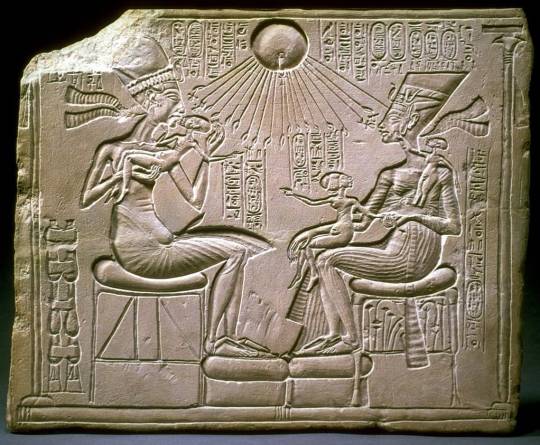
Here, Nefertiti sits on the right side, opposite her husband, Akhenaten. Akhenaten is holding up one of his children, and Nefertiti holds another two children; three of the six daughters that Nefertiti would bear for Akhenaten. The children are depicted in an almost grotesque, alien fashion, though it's not something you can really fault the artists for; it took a long time for artists across the world to realize that babies are not, in fact, just tiny humans, and that their proportions are different. Still, the style of the Amarna period is not helpful; with their large, oval heads, thin limbs, and sagging stomachs, it is difficult to imagine that anyone could be traditionally, Egyptian beautiful. Yet there is still a strange beauty to it; the sagging bellies are meant to call to mind Hapi, a God of great fertility, and the artist's ability to capture the facial features and emotions of their subject is amplified by this new and forgiving artstyle.
This image is a house altar. What that means is that people were encouraged, and evidentially did, worship the royal family in their homes, which is somewhat unprecedented. House altars were usually for Gods such as Tawaret and Bes, who were protectors of the household. But now, with traditional Egyptian religion banned, the typical house altar was now a shrine to Akhenaten and Nefertiti, and by extension, their children, which again shows the importance and power bestowed upon not just the Pharaoh, but his wife as well, as the two are represented in equal size.
Another interesting note about this particular house altar is the thrones on which Akhenaten and Nefertiti are seated. While Akhenaten's seat is mostly blank, Nefertiti is seated upon a throne reserved only for Pharaohs, the reason for this being the decorations which depict the Sema-Tawy ritual; the conjoining of the two lands.
Some time during the course of Akhenaten's reign, he decided to move the capital of Egypt to a deserted stretch of land along the Nile Valley, and called the new city Amarna, for which the period was named after. Here, the royal family took up residence, and this is where the cult center of the Aten would carry out its worship. This is also where Akhenaten royally screwed up his duties in foreign diplomacy, but that is a story for another day.
Before moving to Amarna, Nefertiti had three daughters in Thebes, the previous capital, and three more daughters in Amarna. In order, her daughter's names were Meritaten, Meketaten, and Ankhesenpaaten; then in Amarna, Neferneferuaten Tasherit, Neferneferure, and the youngest, Setepenre. It was to a lesser wife of Akhenaten's that the famous boy Pharaoh Tutankhamun was born, and originally, his name was Tutankhaten.
During his reign, when concerning Nefertiti, Akhenaten placed special attention upon her and loved her dearly, which is why she was one of the most powerful Queens of Egypt. Akhenaten described her as "possessed of charm" and "sweet of love", that "one is happy to hear her voice," and that "contents the Aten with her sweet voice". The two husband and wife were rarely depicted separately, and Akhenaten gave Nefertiti the title of 'heiress', although she was not the daughter of a King. Instead, what many scholars believe Akhenaten meant by this, was that she was to be his successor.
After Akhenaten's death, two Pharaohs ruled for a short time before Tutankhamun took over, and one of those Pharaohs is believed to have possibly been Nefertiti under the name of Neferneferuaten, which means beautiful is the beauty of the Aten. It is still debated whether this was in fact Nefertiti, but given that Nefertiti had given herself the name Neferneferuaten far before Akhenaten's death, and the elvated status gifted by her husband, it seems somewhat likely.
In essence, due to the circumstances of her life and her husband, Nefertiti was elevated to a status that never came before or after her life. Women in ancient Egypt were awarded the same rights as a man, but the wife of the Pharaoh was never depicted as equal to the Pharaoh in such a fashion, as being Pharaoh meant being the intermediary between the heavenly and the earthly, and was a special accorded honour. Nefertiti, perhaps due in part to her charisma and beauty, was given a position equal to the Pharaoh, which never happened unless it was a woman who was becoming Pharaoh. As controversial as Akhenaten's reign was, he did love his wife greatly.
I want to share my opinion on this subject a little, which is essentially to say, that I don't like Akhenaten and I don't try to hide it. His worship of the Aten is alright, but it is the banning of all other worship which rests very uneasily in me. That being said, there is a good source which goes more into detail about Nefertiti, and it is very pro-Akhenaten and anti-ancient Egyptian religion, instead glorifying the monotheism of Atenism and such. Still, it is a valuable resource; Nefertiti and Cleopatra: Queen-monarchs of Ancient Egypt, by Julia Samson, and can be found on Internet Archive here.
131 notes
·
View notes
Photo

A Gallery of Tutankhamun & Family
Tutankhamun is easily the most famous Egyptian ruler in the world thanks to his nearly intact tomb discovered by Howard Carter in 1922 and the "mummy's curse" associated with the opening of that tomb. Although Tutankhamun was initially thought to have been a minor ruler, that opinion has changed, and he is now regarded in a more favorable light.
Tutankhamun (r. c. 1336 to c. 1327 BCE) was the son of Amenhotep IV (better known as Akhenaten) of the 18th Dynasty and his wife Nefertiti. He came to the throne at a young age and died soon after. His father had changed the religious paradigm of polytheism to a monotheistic worship of the god Aten, and the young prince was originally known as Tutankhaten ("living image of Aten") before he changed his name to Tutankhamun ("living image of Amun") when he discarded his father's new religion and returned Egypt to a worship of the old gods, including the popular Amun.
When the general Horemheb (r. 1320-1292 BCE) came to the throne, he tried to erase all evidence of Akhenaten and his family including, of course, Tutankhamun, claiming for himself the role of champion of the old gods and restorer of tradition. Tutankhamun's tomb was accidentally buried later by the workers building the tomb of Ramesses VI (r. 1145-1137 BCE) and was forgotten until its discovery by Carter.
The famous "mummy's curse" or "Curse of Tutankhamun" that became worldwide headlines in 1923 after the "mysterious" death of Carter's patron, Lord Carnarvon, was based on a misinterpretation of an inscription found in the tomb which was reported as reading "I will kill all of those who cross this threshold into the sacred precincts of the royal king who lives forever" but which actually read "I am the one who prevents the sand from blocking the secret chamber" – the "I" being the door. Howard Carter was aware the "curse" was fiction but never challenged it because it kept people away from the tomb, and he could work in peace without constant interruptions. The "curse" also scared people who had either smuggled artifacts out of Egypt illegally or purchased them on the black market into returning them or donating them to museums. There was nothing mysterious about the death of Carnarvon or anyone else associated with opening the tomb. Carter lived until 1939, and Carnarvon's daughter, who was present when the tomb was opened, lived until 1980.
This gallery presents some of the artifacts found in Tutankhamun's tomb as well as images of his parents, the famous image of the young king and his wife Ankhsenamun, and, of course, one of the best-known images associated with ancient Egypt: the golden death mask of Tutankhamun.
Continue reading...
55 notes
·
View notes
Text

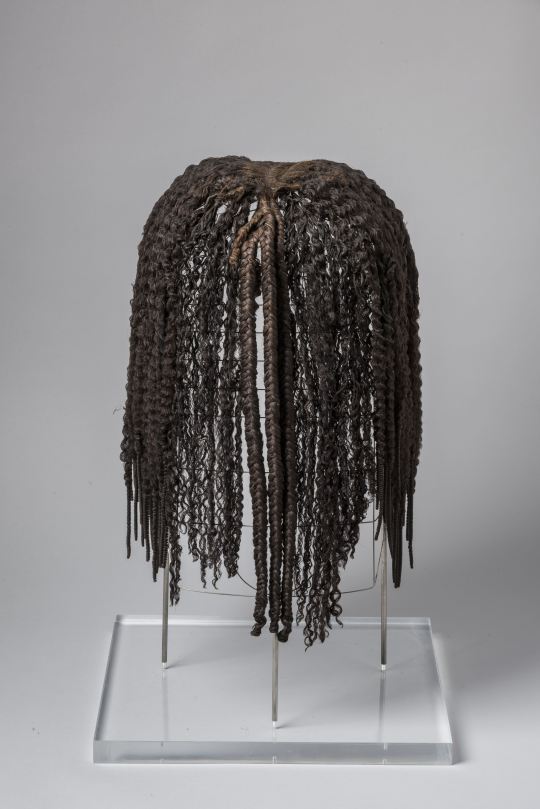
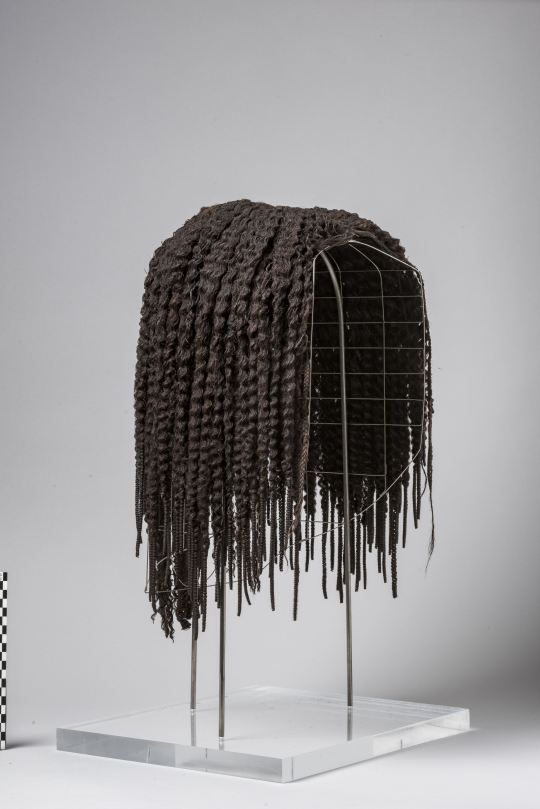


Merit’s wig - Museo Egizio Collection
Inventory Number: S. 8499 New Kingdom, Pre Ramesside, Dynasty 18. 1425–1353 BCE. Reign: Amenhotep II / Tuthmosis IV / Amenhotep III Location Information: Deir el Medina / tomb of Kha (TT8)
Description:
Another exceptional artifact that belonged to Merit is her wig, made with real locks of hair that were sewn together and braided. The hair is parted in the middle and curled into ringlets that end with braids on either side of the face and on the back of the neck. This type of hairdo was often decorated with flowers and diadems, which were very fashionable in the mid-18th dynasty, as can be seen in the paintings and statues of the period.
#merit#new kingdom#new kingdom pr#S. 8499#museo egizio#deir el medina#tomb of kha#womens hair and wigs#NKPRWHW#upper egypt#wig#merits wig
73 notes
·
View notes